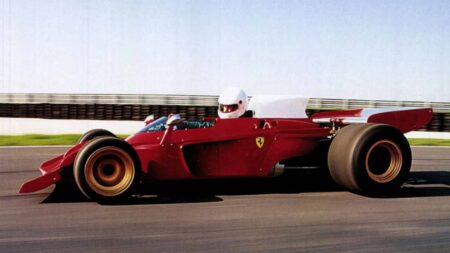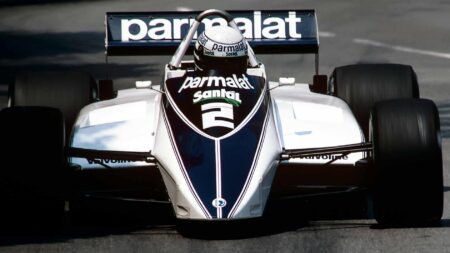The Tecno’s opening two grands prix set the tone for a year in which Galli and Bell completed just 126 racing laps between them in six GP starts. The highlight was Galli’s third place in a poorly attended non-championship race at Vallelunga.
This lack of success explains why Yorke decided to take matters into his own hands and build a ‘British’ Tecno with Martini money. But why he chose a company set up by a designer of dumper trucks and a journalist to produce the car is a mystery Yorke took to his grave.
Gordon Fowell was an old friend of Yorke’s, but his only involvement in motorsport up to that time was as an amateur driver and partner to journalist Alan Phillips in a company that released audio tapes of racing engines. Goral Engineering was their next venture.

Amon edges out of the Zandvoort pitlane for fiuitless testing of the ‘British’ Tecno
Pederzani, meanwhile, wasn’t to be outdone and decided that he would also produce a monocoque car. He touted around a number of British-based designers and ended up recruiting McCall, whose Tui Formula Two and Atlantic machinery had shown promise over the previous couple of seasons.
“Luciano was offended because Yorke had suggested that Italians couldn’t do monocoques,” says McCall. “My car was intended as nothing other an exercise to show that he could build his own tub.” Work on the McCall Tecno started on New Year’s Eve, 1972. Just 10 weeks later, PA123-006 — which retained only the type number and the rear end of the previous design — was on its wheels. How this chassis came to be taken over by Yorke isn’t clear. McCall claims that the idea to race his car came up only as it neared completion.
“When Pederzani saw the thing he suddenly got excited about racing it,” remembers the designer, who corroborates press reports of the time that the car could have raced as a Tecno Tui. “He went out and found some sponsorship and asked me to find a driver.”
The name McCall put forward was Chris Amon. But the former Ferrari driver’s recollection of events is that he was approached by Yorke, not McCall. His return to the works March squad, having fallen through in early January, Chris was glad of the approach.
“When I agreed to drive I had no idea what car I’d be driving,” explains Amon, whose contract was with Martini. “Then Yorke filled me in, explaining that the McCall chassis was nearly ready and that Fowell’s would be for later.”
“As soon as Luciano found out he went home and said that he would never be seen at a racetrack again”
It was an awkward time. McCall claims that Yorke “rode roughshod over the Pederzanis” with the result that Luciano “felt insulted”. McCall’s right-hand man, Eddie Wies, recalls “the British turning up one day, covering our car in Martini stickers and claiming it as theirs”. It was the start of an irreconcilable breakdown in the relationship between the British and Italian sides of the team.
“After that Luciano said he was only going to fulfil his obligations, and no more,” explains McCall, who left Tecno immediately after his creation’s first test. “His contract was to supply engines, transport and the mechanics. He’d built something like 12 engines, but no development was undertaken. He didn’t even put them on the dyno.”
That tallies with Amon’s description of the engines getting worse through the season, and explains why he and Yorke went home for good after qualifying for the Austrian Grand Prix, claiming no engines were available.






